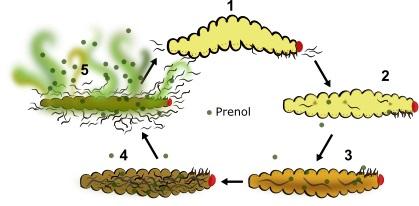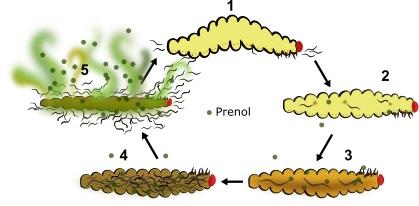
Credit: UC Riverside
RIVERSIDE, Calif. — Tiny eel-like creatures called nematodes are surrounding us. While they can be free-living (a cup of soil or seawater contains thousands), the most well-known nematodes are the parasitic kind that wreak havoc in people, animals and plants.
Despite their reputation, scientists at the University of California, Riverside are studying nematodes as a force for good: to kill insects that infect crops and trees.
In a paper published today in Scientific Reports, a team led by Adler Dillman, assistant professor of parasitology in UCR's College of Natural and Agricultural Sciences, has shown how nematodes use smell to seek out uninfected insects, which they then enter and kill. The findings support the group's long-term goal of improving how gardeners and the agricultural industry use nematodes in biological pest management.
Nematodes, which are transparent or milky white unsegmented worms between 0.1 and 2.5 millimeters long, represent a whopping 80 percent of all animal life on earth. The varieties that infect insects, such as the Steinernema carpocapsae species studied at UCR, enter their hosts through natural body openings, replicate, and secrete a deadly cocktail of proteins. These nematodes show promise as biological insecticides for more than 250 pests that attack plants such as corn, oranges, tomatoes, peaches, and pine trees.
While previous research has shown that nematodes can differentiate between insects that have already been infected and those that have not, the mechanism by which this occurs has remained a mystery. In the current study, the researchers discovered that infected insects emit an odor called prenol that is repulsive to nematodes looking for a new host.
"The nematodes are using odors like prenol to identify insects that are already infested and therefore not worth infecting because they have depleted resources. Instead the parasites are more likely to choose insects that are not emitting prenol, since those represent untapped resources," said Tiffany Baiocchi, a graduate student in Dillman's lab and the lead author on the paper.
An unexpected plot twist was the team's finding that some insect larvae are attracted to prenol, suggesting the same odor that signals nematodes to steer clear of an infected insect may also attract uninfected insects to that area.
"This is a cunning way of attracting new hosts for the generation of nematodes that will emerge from the infected insect cadaver. The way that nematodes can essentially engineer the recruitment of new insects toward them is certainly something we can exploit in our efforts to improve nematode-based biological control," Dillman said.
###
The title of the paper is "Host Seeking Parasitic Nematodes Use Specific Odors to Assess Host Resources." In addition to Dillman and Baiocchi, contributors include: Grant Lee, an undergraduate researcher, and Dong-Hwan Choe, an assistant professor in entomology, who used mass spectrometry to help identify the odors. The work as supported by the National Institutes of Health.
Media Contact
Sarah Nightingale
[email protected]
951-827-4580
@UCRiverside
http://www.ucr.edu
Original Source
https://ucrtoday.ucr.edu/48320 http://dx.doi.org/10.1038/s41598-017-06620-2





